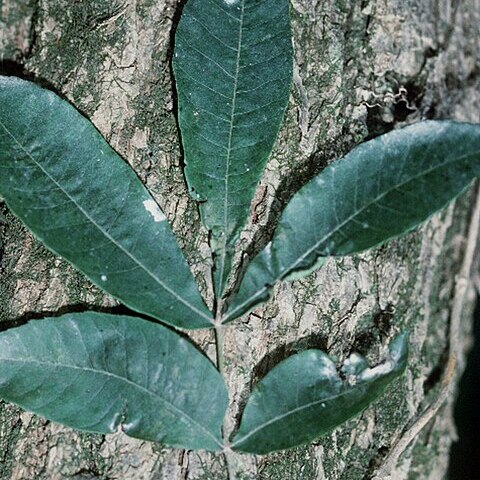Trees , to 46 m. Bark light gray or brownish, exfoliating, separating freely into long strips or broad plates, less commonly with small platelike scales. Twigs brown to reddish brown or black, slender, villous becoming glabrous. Terminal buds brown, reddish brown, or black, oblong, 8-10 mm, yellow-scaly, villous; bud scales valvate; axillary buds protected by bracteoles fused into hood. Leaves 4-6 dm; petiole 3-8 cm, villous becoming glabrous. Leaflets (5-)9-11(-13), lateral petiolules 0-2 mm, terminal petiolules (2-)6-10(-14) mm; blades ovate-lanceolate, often falcate, 2-19 × 1-4 cm, margins finely or coarsely serrate to entire and wavy, without tufts of hairs, apex acuminate; surfaces abaxially villous with unicellular and 2-8-rayed fasciculate hairs along midrib and secondary veins, densely scaly in spring with large peltate scales and small round, irregular, and 4-lobed peltate scales, adaxially villous along midrib near base, glabrous between veins. Staminate catkins pedunculate, to 21 cm, stalks villous, bracts scaly; anthers without hairs. Fruits brown, bronze, or black, obovoid, compressed, 1.5-3 × 1.5-2.5 cm; husks rough, 1 mm thick, dehiscing to base or nearly so, sutures winged; nuts chocolate brown, broadly obovoid, compressed, 2-angled, verrucose; shells thin. Seeds bitter. 2 n = 32.
More
A deciduous tree. It grows 21 m high. It spreads to 12 m wide. The trunk is tall and straight. The bark is light brown and peels off. The leaves are sword shaped and 12 cm long. They have about 13 individual leaflets. There are fine teeth along the edge. The flowers are small and greenish. The male flowers are in slender drooping catkins and the female flowers are in groups or 2-10 at the tips of the same twigs. The fruit is egg shaped. It is 2.5-4 cm long and flattened with 4 wings.
A temperate plant. It grows in low, wet flatlands. It is often on clay soils and can be partly in water. It needs an open, sunny position. It is resistant to frost but damaged by drought. It suits hardiness zones 6-9.
More
Bottomlands and swamps, in ground that is often inundated for at least part of the year. The best specimens grow on deep well-drained alluvial soils.

